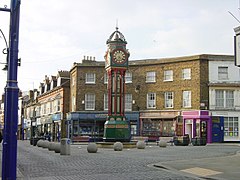Sheerness
| Sheerness | |
|---|---|
 Sheerness clock tower |
|
| Sheerness shown within Kent | |
| Population | 11,938 (2011 census) |
| OS grid reference | TQ919749 |
| • London | 37 miles (60 km) W |
| District | |
| Shire county | |
| Region | |
| Country | England |
| Sovereign state | United Kingdom |
| Post town | SHEERNESS |
| Postcode district | ME12 |
| Dialling code | 01795 |
| Police | Kent |
| Fire | Kent |
| Ambulance | South East Coast |
| EU Parliament | South East England |
| UK Parliament | |
Sheerness /ʃɪərˈnɛs/ is a town located beside the mouth of the River Medway on the north-west corner of the Isle of Sheppey in north Kent, England. With a population of 12,000 it is the largest town on the island.
Sheerness began as a fort built in the 16th century to protect the River Medway from naval invasion. In 1665, plans were first laid by the Navy Board for Sheerness Dockyard, a facility where warships might be provisioned and repaired. The site was favoured by Samuel Pepys, then Clerk of the Acts of the navy, for shipbuilding over Chatham. After the raid on the Medway in 1667, the older fortification was strengthened; in 1669 a Royal Navy dockyard was established in the town, where warships were stocked and repaired until its closure in 1960.
Beginning with the construction of a pier and a promenade in the 19th century, Sheerness acquired the added attractions of a seaside resort. Industry retains its important place in the town and the Port of Sheerness is one of the United Kingdom's leading car and fresh produce importers. The town is the site of one of the UK's first co-operative societies and also of the world's first multi-storey building with a rigid metal frame.
The first structure in what is now Sheerness was a fort built by order of Henry VIII to prevent enemy ships from entering the River Medway and attacking the naval dockyard at Chatham. In 1666 work began to replace it with a stronger fort. However, before its completion, this second fort was destroyed during the 1667 Dutch raid on the Medway. The Secretary of the Admiralty, Samuel Pepys, subsequently ordered the construction of Sheerness Dockyard as an extension to that at Chatham.
...
Wikipedia

